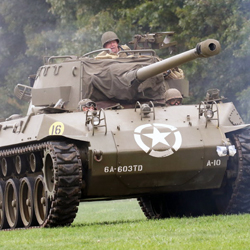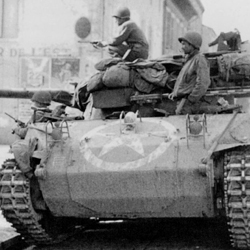The story of the M18 is the story of the United States’ somewhat underdeveloped strategy behind tank destroyers up through World War Two, also known as tank destroyer doctrine. Due to many factors, such as an outdated prevailing strategical theory from WWI that tanks should only exist as infantry support vehicles, some fighting between the different military arms to decide who should have control over tank destroyers, and a surprisingly blasé attitude towards the German blitzkrieg that crushed Polish defenses in a month, it wasn’t until the German victory over France and the Allied forces took place in June of 1940 that the US really started taking tank destroyer doctrine seriously.
The development of tank destroyer doctrine didn’t really get off the ground until 1941 due to the aforementioned infighting between the military arms, and because no one could figure out who had dominion over tank destroyers it was decided that a new quasi-branch known as the Armed Ground Forces would be created to oversee their development. This meant that the United States only had one year to develop their strategy on how to deal with might of the German tanks before they were thrust into battle to face them.
This shortened time span for developing a successful strategy culminated in the M18. The result was a tank destroyer that was light, weighing only 39,000lbs (26,000 less than its predecessor the M10) and maneuverable, clocking in with a top speed of 45 to 50 mph, making it one of the fastest armored and tracked vehicle used by any side throughout the war. The speed came at a cost of armor, however, which was only 12mm in the thickest parts. This made any head to head fight with a German tank a death sentence if not handled carefully. Its 76mm cannon was the same cannon being fitted onto the M4 Sherman when the Hellcat started coming off the assembly line, and although field tests claimed that the cannon could pierce German armor at 1000 yards, by the time the Hellcat first entered service in Italy during the spring of 1944, it turned out advances in German armor meant the M18 only had an effective range of about 300 yards.
Even though the M18 was designed primarily to be a tank destroyer, the weakened efficacy of its cannon lead to the Hellcat taking on a number of roles that it was not initially intended for, such as serving in combined arms maneuvers as well as acting as infantry support. With that being said, however, the Hellcat turned out to be one of the finest tank destroyers employed by the US during WWII. Despite the decidedly poor killing power that the M18 had and the thin armor plating that encased the crew, the Hellcat’s deftness and superior mobility allowed the tank destroyer to move around faster than enemy turrets could track, which afforded Hellcat crews the opportunity to aim for the weaker side armor in German Panther and Tiger tanks. Furthermore, Hellcat crews, like many tanker crews that served in the US during WWII, were some of the most adept at developing cunning new strategies to win battles by developing an all-encompassing working knowledge of the Hellcat’s strengths and weaknesses, as well as those of the enemy tanks.
One of the most famous examples of Hellcat crew tactical proficiency occurred during the battle of Arracourt in France on September 19th, 1944. Under the cover of fog at dawn, four Hellcats from the 704th Tank Destroyer Battalion snuck up on a group of Panthers from the 113th Panzer Brigade, destroying seven before falling back. Later on, the 113th pressed an attack on what seemed like a group of Hellcats that were all alone, unaware that two more platoons were on their way to flank the Panthers. While being fired on from three sides, the 113th suffered four Panther losses before retreating, which was pressed by all three Hellcat platoons. At the end of the battle, thirty-nine total Panther kills were recorded by these Hellcats with only seven losses.
For many, the Hellcat wasn’t a tank destroyer without its faults. Crews praised its speed and mobility, but the exposed .50 caliber gun and open turret made them more unsafe against enemy ordinance and in the winter the open top combined with the air-cooling system for the engine turned the M18 into an ice box. Furthermore, the awkward way the inside of the tank was designed made it hard for crews to reload quickly and often with its almost nonexistent armor Hellcats would be sitting ducks for enemy tanks. Despite its flaws, the M18 was an incredibly agile tank that served a large multitude of roles with great success and was generally quite liked by its crews.
Hellcat tank kills skied high due to the ingenuity of those who operated it, in total destroying 526 enemy tanks; 498 kills were recorded in the European theater, and 28 in the Pacific. For those 526, only 216 total M18s were lost. That means for every 1 Hellcat destroyed, 2.4 enemy tanks were, which accounts for the highest kill to death ratio of all tank destroyers employed during WW







